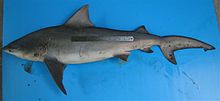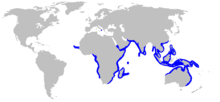| Pigeye shark | |
|---|---|

| |
| Scientific classification | |
| Domain: | Eukaryota |
| Kingdom: | Animalia |
| Phylum: | Chordata |
| Class: | Chondrichthyes |
| Subclass: | Elasmobranchii |
| Order: | Carcharhiniformes |
| Family: | Carcharhinidae |
| Genus: | Carcharhinus |
| Species: | C. amboinensis
|
| Binomial name | |
| Carcharhinus amboinensis | |

| |
| Range of the pigeye shark[2] | |
| Synonyms | |
|
Carcharias amboinensis Müller & Henle, 1839
| |
The pigeye shark or Java shark (Carcharhinus amboinensis) is an uncommon species of requiem shark, in the family Carcharhinidae, found in the warm coastal waters of the eastern Atlantic and western Indo-Pacific. It prefers shallow, murky environments with soft bottoms, and tends to roam within a fairly localised area. With its bulky grey body, small eyes, and short, blunt snout, the pigeye shark looks almost identical to (and is often confused with) the better-known bull shark (C. leucas). The two species differ in vertebral count, the relative sizes of the dorsal fins, and other subtle traits. This shark typically reaches lengths of 1.9–2.5 m (6.2–8.2 ft).
The pigeye shark is an apex predator that mostly hunts low in the water column. It has a varied diet, consisting mainly of bony and cartilaginous fishes and also including crustaceans, molluscs, sea snakes, and cetaceans. This species gives birth to live young, with the developing embryos sustained to term via a placental connection to their mother. Litters of three to thirteen pups are born after a gestation period of nine or twelve months. Young sharks spend their first few years of life in sheltered inshore habitats such as bays, where their movements follow tidal and seasonal patterns. The pigeye shark's size and dentition make it potentially dangerous, though it has not been known to attack humans. The shark is infrequently caught in shark nets protecting beaches and by fisheries, which use it for meat and fins. The IUCN presently assesses this species as vulnerable.
- ^ Simpfendorfer, C.; Bin Ali, A.; Derrick, D.; Yuneni, R.R.; Utzurrum, J.A.T.; Seyha, L.; Fernando, D.; Fahmi, Haque, A.B.; Tanay, D.; Vo, V.Q.; , D.; Bineesh, K.K.; Espinoza, M. (2021). "Carcharhinus amboinensis". IUCN Red List of Threatened Species. 2021: e.T39366A173434051. doi:10.2305/IUCN.UK.2021-2.RLTS.T39366A173434051.en. Retrieved 19 November 2021.
{{cite journal}}: CS1 maint: multiple names: authors list (link) - ^ Cite error: The named reference
voigt and weberwas invoked but never defined (see the help page).
